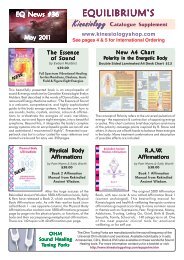You also want an ePaper? Increase the reach of your titles
YUMPU automatically turns print PDFs into web optimized ePapers that Google loves.
Weight Test Kit<br />
38 vials<br />
This kit draws together vials that are spread across other kits. There are no vials which are unique to<br />
this kit. They include hormones, enzymes, amino acids, etc. that affect metabolism, blood glucose levels,<br />
gastric emptying and appetite control. Vials include insulin, glycogen, T4, T3, reverse T3, leptin,<br />
neuropeptide Y, carnitine, etc. 38 vials<br />
The information here just focusses on the role of these in blood sugar control, appetite management and<br />
metabolism.<br />
WT01 Anandamide<br />
May increase appetite.<br />
WT02 Arginine<br />
An amino acid. Involved with glucose control mechanism in blood; enhances fat metabolism; involved in<br />
insulin production; stimulates human growth hormone.<br />
WT03 Carnitine<br />
An amino acid. Major role in transferring fatty acids into cells where used as energy sources; mobilising fatty<br />
deposits in obesity.<br />
WT04 CART<br />
Modulates the action of leptin and neuropeptide Y and so reduces appetite.<br />
WT05 CCK / Cholecystokinin<br />
Stimulates a feeling of satiety; may regulate feeding as a “stop eating” signal.<br />
WT06 Corticotropin Releasing Hormone / CRH<br />
Involved in the regulation of food intake.<br />
WT07 Cortisol / Hydrocortisone<br />
The principal gluccocorticoid; increases blood glucose levels by increasing cellular utilisation of proteins and<br />
fats as energy sources thus conserving glucose; stimulates liver cells to produce glucose from amino acids<br />
and fats.<br />
WT08 Cylic AMP / Cyclic Adenosine-3’,5’ - Monophospate<br />
Causes adipose cells to break down triglycerides and release fatty acids more rapidly; stimulates thyroid<br />
cells to secrete more thyroid hormone.<br />
WT09 Dipeptidyl Peptidase IV<br />
Arrests biological activity of GLP1 and Substance P.<br />
WT10 Epinephrine/ Adrenaline<br />
Slows digestion, increases blood sugar.<br />
WT11 Exendin (9-39)<br />
Reduces glucose levels; competes for the same brain receptors as GLP1 and so blocks the effect of GLP1<br />
and stimulates appetite.<br />
WT12 Galanin<br />
Stimulates the appetite.<br />
WT13 Ghrelin<br />
Increases appetite; may be a hormonal link between stomach, hypothalamus and pituitary and so regulate<br />
energy balance; regulates growth hormone secretions; may signal to the hypothalamus when an increase in<br />
metabolic efficiency is necessary.<br />
WT14 Glucagon<br />
Raises blood sugar levels by accelerating breakdown of glycogen into glucose in the liver, converting other<br />
nutrients into glucose in the liver, and releasing glucose into the blood – opposes the action of insulin.<br />
WT15 Glucagon-Like Peptide 1/GLP1<br />
Stimulates production of insulin; inhibits production of glucagon and gastric emptying; reduces appetite; lowers<br />
blood glucose in people with diabetes.<br />
WT16 Glucocorticoids<br />
Conversion of non-carbohydrates into energy.<br />
Page 154 Copyright Jane Thurnell Read 2012 Testing Kit Description Manual



